Coastal Birds in South Carolina
Piping Plover
The Piping Plover is a stout, sandy colored shorebird. In the summer, these plovers have orange bills and orange legs and males have a thick black neck band. Piping Plovers feed on invertebrates in the soil such as polychaetes and amphipods.
There are three populations of Piping Plovers, that are distinguished by their nesting location.
| Breeding Region | Conservation Status |
|---|---|
| Atlantic Coast | Threatened |
| Northern Great Plains of U.S. & Canada | Threatened |
| Great Lakes of U.S. & Canada | Endangered |

Piping Plovers of each population over winter in the southeastern U.S., along the gulf coast, and in the Bahamas. In addition to providing habitat for Piping Plovers during their fall and spring migration, South Carolina hosts a number of Piping Plovers during the winter. In South Carolina, Piping Plovers overwinter along inlets of barrier beaches and on ephemeral sandbar beaches and uninhabited islands. SCDNR partners with U.S. Fish & Wildlife Service (USFWS) to resight uniquely color banded Piping Plovers during spring and fall migration and winter to help determine survival rates, foraging areas, and site fidelity. Threats to these birds include disturbance to nesting areas, coastal development, and degradation of foraging areas from shoreline modification.
- Endangered Species Facts: Piping Plover (USFWS)
- Atlantic Coast Piping Plover Recovery Plan (USFWS)
- Band Resighting (USFWS)
- Report a banded Piping Plover (USFWS)
- Band Reporting and Resighting Guide (Virginia Tech)
Special Thanks to Melissa Bimbi, USFWS South Carolina Field Office.
